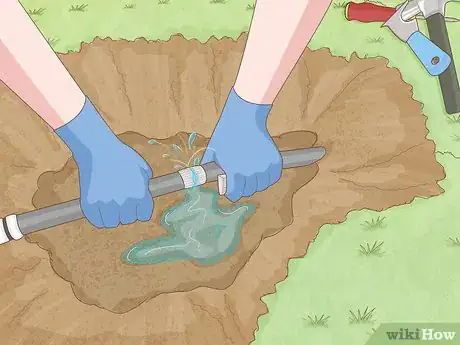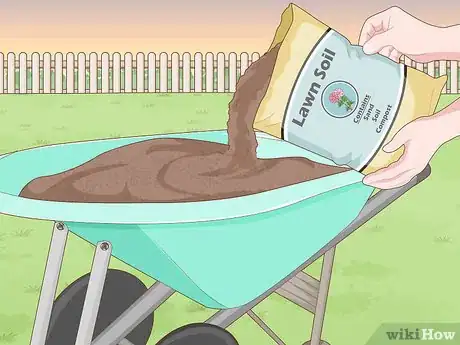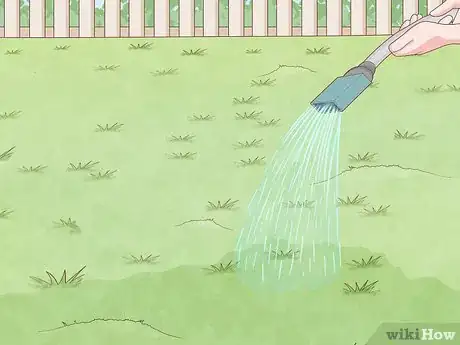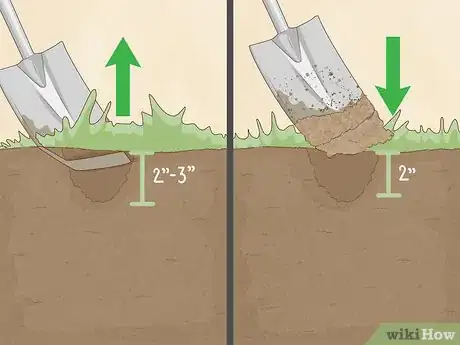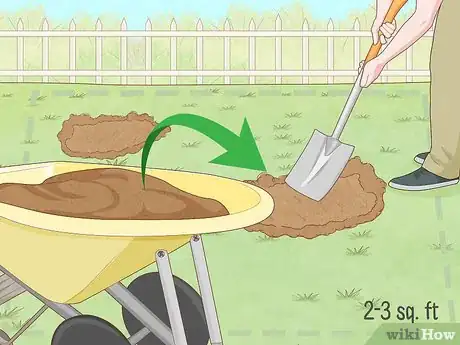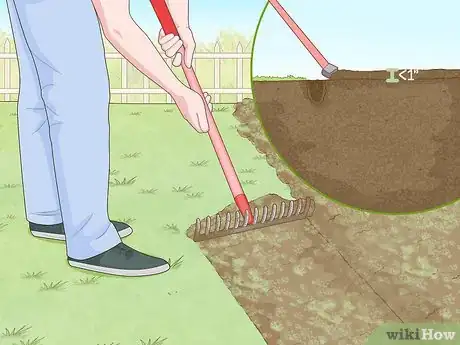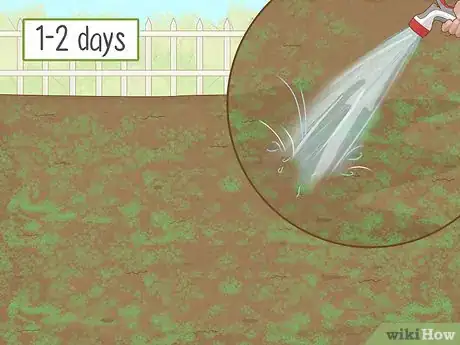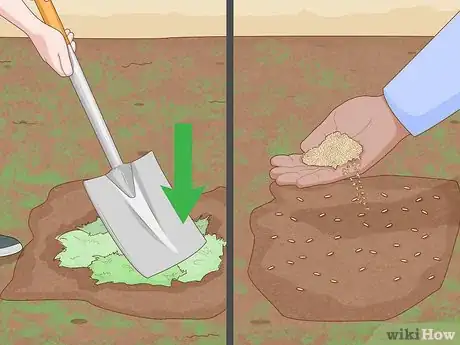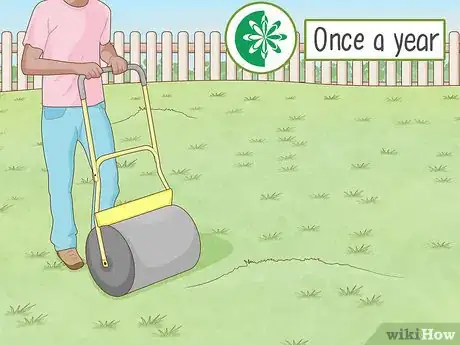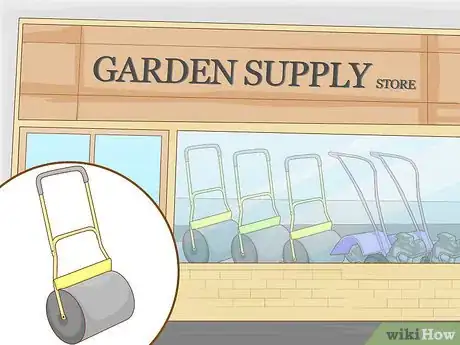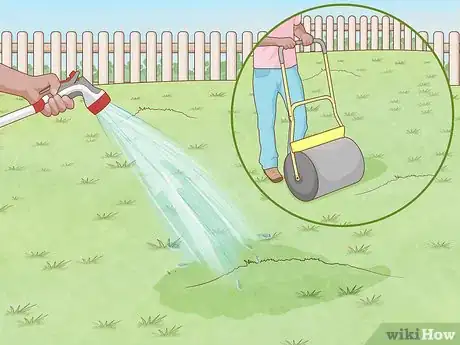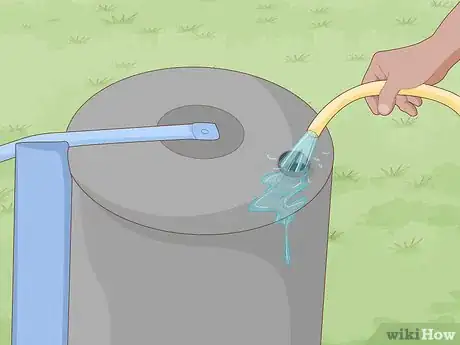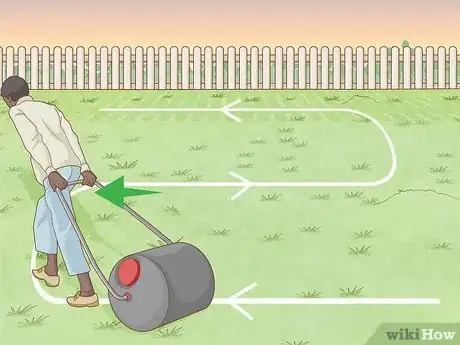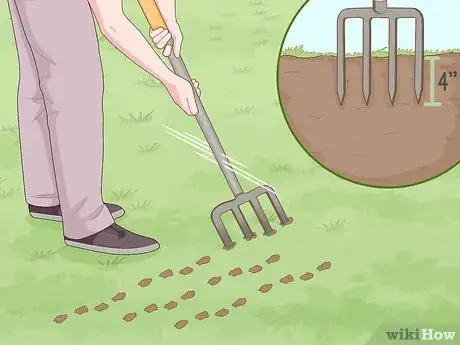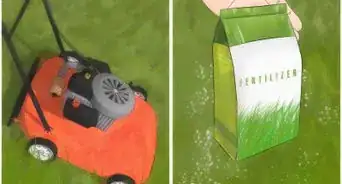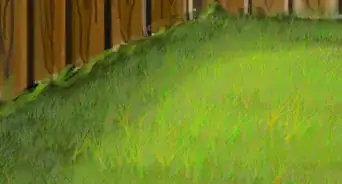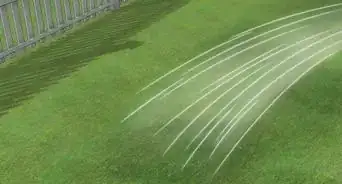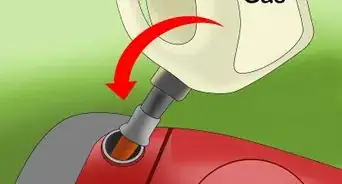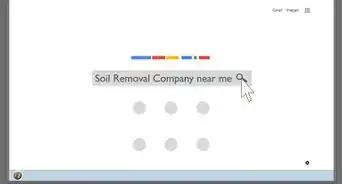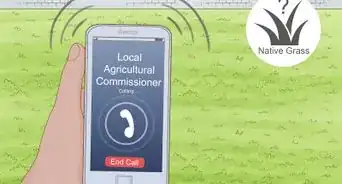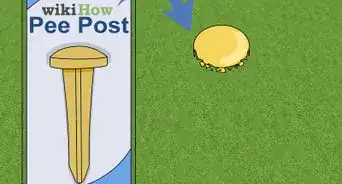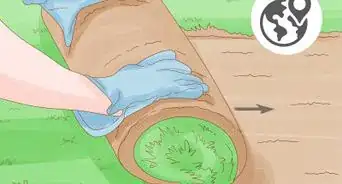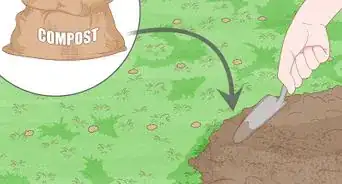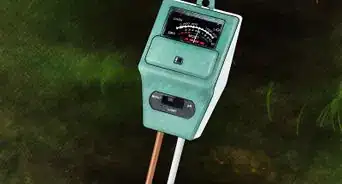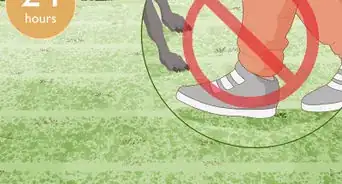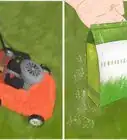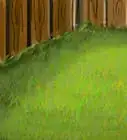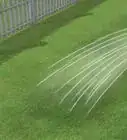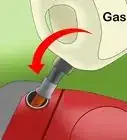This article was co-authored by Keith Souza and by wikiHow staff writer, Hunter Rising. Keith Souza is a Home Improvement Specialist and the Owner of Vaulted Hammer Handyman Services. He specializes in home repair, home automation, and yard maintenance. Keith holds an AAS in Electronics Technology from Heald College.
There are 16 references cited in this article, which can be found at the bottom of the page.
wikiHow marks an article as reader-approved once it receives enough positive feedback. In this case, 100% of readers who voted found the article helpful, earning it our reader-approved status.
This article has been viewed 1,374,042 times.
Are you tired of seeing all the bumps and lumps in your yard? Not only are they a safety hazard, but they make your lawn look a little unsightly. While the easiest way to level out your yard is by filling holes and low spots, flattening out the raised bumps and ridges with a lawn roller could work just as well. We’ll walk you through each technique so you have a perfectly flat and level lawn once you’re finished.
Things You Should Know
- Fill in low spots in your yard with lawn soil and level them out with a rake. Dig out grass from spots 2–3 inches (5.1–7.6 cm) deep with a shovel before filling them.
- Pull a lawn roller in strips across your yard to flatten bumps.
- Dig out compacted dirt from raised areas of your yard that aren’t leveled out with a roller.
Steps
Filling Low Spots
-
1Fill low spots in your lawn during the fall or spring. Pick a few days at the beginning of the fall or spring when the weather is mild to top-dress your lawn.[1] Work 3-4 weeks before the severe heat of summer or the cold of winter so new grass has time to establish before the weather turns.[2]
- Either fill in all the low spots in your yard if you have the time or work in sections to flatten small areas of your yard.
-
2Check your yard for drainage issues or broken pipes. Contact your city’s water department to help you locate where the pipes run underneath your yard. Look for areas in your yard where water pools up, and hire a professional plumber to inspect if there are any damaged pipes. Have any broken or damaged pipes repaired before you level your lawn to ensure the low spots don’t form again.[3]
- Contact a professional landscaper to determine the source of your drainage issues if there aren’t any damaged pipes. You may need to fix poor drainage or have your lawn re-graded.
Advertisement -
3Break apart lawn soil in a wheelbarrow. Get a bag of lawn soil that contains sand, soil, and compost to use as top-dressing in your yard. Use a rake to sift through the soil and break apart any clumps larger than 1⁄4 in (0.64 cm) so it spreads across your lawn evenly.[4]
- If your yard already has sandy soil, it’s okay to just use only sand.[5]
Tip: Mix your own top-dressing with equal parts of sharp sand, topsoil, and peat moss.
-
4Water your lawn to compact the soil. Use a shower attachment on your hose and lightly water the section of lawn that you’re filling in. Make sure the soil feels soft underneath your grass instead of hard and dry.[6]
- The water helps your soil settle so you’re able to see the actual depth of the holes you need to fill.
-
5Remove the grass if the hole is deeper than 2–3 in (5.1–7.6 cm). Deep soil that’s covering grass can cause decay and harm the rest of your lawn. Measure how deep the holes in your yard are to see if they are deeper than 2–3 inches (5.1–7.6 cm). If they are, push the blade of a shovel around the patch to cut and remove the grass from the surface.[7]
- If the hole is shallower than 2 inches (5.1 cm), then it’s okay to put soil directly on the grass.
- Save the grass if you can because you may be able to replant it when you’re finished filling in the holes.
-
6Fill the low spots in your lawn with the lawn soil. Work in 2–3 sq ft (0.19–0.28 m2) sections across your yard. Spread a few shovelfuls of the soil from your wheelbarrow into ruts or holes in your yard. Try to spread the soil evenly across the holes in the area. Tamp the dirt into the holes with the back of your shovel.[8]
- It’s okay if the soil isn’t perfectly flat when you shovel it in since you’ll level it out later.
- Cutting your grass as low as possible can help you get a more accurate view of your lawn’s level.[9]
-
7Spread the soil evenly with a garden rake. Alternate between using the pronged side of the rake and the flat edge on the back to flatten the soil. If the low spots in your yard aren’t completely filled, add a little bit more lawn soil and level it out. Keep working the soil throughout your lawn until you can see the grass poking through the top-dressing you just added.[10]
- Make sure your layer of top dressing is less than 1 in (2.5 cm) thick or else it could cause your existing grass to die.
- Alternatively, run a manual leveler over your grass to smooth it out.[11]
-
8Water the soil and let the topsoil settle for 1-2 days. Use your hose or a sprinkler to water the area thoroughly and let the soil settle. Leave your yard alone for 1-2 days so the soil has time to compact before inspecting if it’s level again.[12]
- If the soil settled and the spots still aren’t level, then add more soil to fill in the holes again.
-
9Replant grass in any bare spots (if you need to). Look for any bare spots in your lawn where you had to remove your grass. First, try fitting the old patch of grass over the spot and tamping it down so the roots make good contact with the soil. If the old patch doesn’t fit, then plant new seeds.[13]
- Use sod if you don’t want to wait for new grass to grow in. Cut the sod into the shape of the bare spot and press it down onto the soil.
- Use the same type of grass as the rest of your lawn so your yard looks uniform.
-
10Check the level of your lawn with lumber and a level. Once the soil settles, lay a 2 in × 4 in (5.1 cm × 10.2 cm) board that’s long enough to span across the area you flattened. Set your level on top of the lumber and check the bubble. If the bubble is in the center of the tube on your level, then you’re finished flattening your lawn. If it isn’t, find the low spots and fill them in with more top-dressing.[14]
- If your lumber doesn’t span the entire area you leveled, you may get an inaccurate reading.
Flattening Raised Mounds with a Lawn Roller
-
1Roll your lawn yearly in the spring to avoid over-compacting your soil. Rolling your lawn compacts the soil and could make it more difficult for roots to grow if you overdo it. Only roll your lawn once a year in the spring to prepare for the rest of the growing season.[15]EXPERT TIPJeremy Yamaguchi is a Lawn Care Specialist and the Founder/CEO of Lawn Love, a digital marketplace for lawn care and gardening services. Jeremy provides instant satellite quotes and can coordinate service from a smartphone or web browser. The company has raised funding from notable investors like Y Combinator, Joe Montana, Alexis Ohanian, Barbara Corcoran and others.Lawn Care Specialist

 Jeremy Yamaguchi
Jeremy Yamaguchi
Lawn Care SpecialistDid You Know? There are several reasons lawns can be bumpy. You might have drainage problems like broken water or irrigation pipes that are causing erosion. How you treat the lawn depends on the underlying causes.
-
2Buy or rent a lawn roller. Garden rollers are large cylinders that you fill with water and pull across your lawn to flatten any mounds that are too tall. Get a roller for yourself, or contact your local gardening or landscaping stores to see if they offer equipment rentals so you’re able to save some money.[16]
- Steel garden rollers are heavier and flatten your lawn better, but they’re tougher to maneuver.
- Polyurethane rollers are lighter and easier to move around, but they are less durable and could get punctured.
Tip: If you have a riding lawnmower, get a roller than attaches to it. That way, you don’t have to push it by hand and it’s easier to level a larger yard.
-
3Water your lawn before you roll it. Use a sprinkler attachment on your garden hose to wet your grass. Run the sprinkler on your lawn for about 20-30 minutes so your lawn doesn’t get too wet. Just avoid watering your lawn so much that it turns muddy since you’ll have to wait for it to dry before rolling.[17]
- The water moistens the soil so it’s softer and easier to flatten with your roller.
-
4Fill the roller barrel ¼-full with water. Garden rollers are hollow so you can transport them easily, but they’re not heavy enough to flatten your lawn yet. Turn the roller on its side so the fill hole points up, and use your hose to fill it with water. Once it’s ¼-full, turn off your hose and seal the cap.[18]
- Refer to the instruction manual if you have trouble locating the fill hole on your roller.
- It’s okay to fill the entire roller with water, but it will be extremely heavy and could be difficult to maneuver around your yard.
-
5Pull the roller across your lawn in long strips. Start at the end of your yard furthest from your home. Slowly walk across the length of your lawn and pull the roller behind you to flatten the raised areas of your yard. When you reach the other end of your lawn, turn the roller around and start a new strip that slightly overlaps the first one. Keep working across your lawn until you’ve rolled it completely.[19]
- Try pushing the roller in front of you if it’s easier to maneuver.
- Take breaks frequently so you don’t get sore or worn out.
- If your yard has a hill or slope, work across it horizontally rather than moving up and down. The weight of the roller could make it difficult to push uphill.
- If your yard isn’t leveling out, try adding more water to the roller so there’s more weight pressing down on the soil.
-
6Cut the grass and dig out soil from large bumps if they aren’t flattened. Walk over your lawn after you’ve rolled it to see if there are still any mounds left. If there are, use a shovel to cut into the grass. Try to peel back the grass around the mound, and dig out some of the soil from the mound. Fold the grass back down occasionally and tamp it down with the back of your shovel to check if the spot is level with the rest of your lawn.[20]
- Mounds that don’t flatten out with the roller are usually compacted and need to be removed by hand.
- If you can’t easily peel the grass back from the dirt, just cut out the section of your lawn with your shovel. When you’re finished, put the grass back over the patch or plant new grass seed on the bare soil.
-
7Aerate your lawn to let in air and water. Poke the end of a garden fork 4 inches (10 cm) into the ground and rock it slightly back and forth to loosen the soil. Work your way across your lawn until it’s completely aerated.[21]
- Aerating your lawn helps water and air get into compacted soil so your plants can easily grow.[22]
- Use a gas-powered aerator to make the job quicker.
Community Q&A
-
QuestionHow much does it cost to level a lawn?
 wikiHow Staff EditorThis answer was written by one of our trained team of researchers who validated it for accuracy and comprehensiveness.
wikiHow Staff EditorThis answer was written by one of our trained team of researchers who validated it for accuracy and comprehensiveness.
Staff Answer wikiHow Staff EditorStaff AnswerIf you’re hiring a professional to level a large, very uneven or sloping lawn, you may be looking at a price tag of around $2,000 or more. However, if you just need to flatten out a few lumps and bumps, the cost may be closer to $500. You’ll save a lot of money by doing the work yourself, but you’ll likely still need to spend some money on materials and tools.
wikiHow Staff EditorStaff AnswerIf you’re hiring a professional to level a large, very uneven or sloping lawn, you may be looking at a price tag of around $2,000 or more. However, if you just need to flatten out a few lumps and bumps, the cost may be closer to $500. You’ll save a lot of money by doing the work yourself, but you’ll likely still need to spend some money on materials and tools. -
QuestionCan you put topsoil over your grass and then reseed?
 wikiHow Staff EditorThis answer was written by one of our trained team of researchers who validated it for accuracy and comprehensiveness.
wikiHow Staff EditorThis answer was written by one of our trained team of researchers who validated it for accuracy and comprehensiveness.
Staff Answer wikiHow Staff EditorStaff AnswerYes. This process is known as topdressing. Aerate your lawn first to allow the topdressing to penetrate better, then rake the soil mixture over any low spots or bald patches. If your grass is healthy and the depression you’re filling isn’t too low, you may not even need to reseed—just let your original grass peek through. You might need to reseed in bald areas or in places where you’ve filled a large hole.
wikiHow Staff EditorStaff AnswerYes. This process is known as topdressing. Aerate your lawn first to allow the topdressing to penetrate better, then rake the soil mixture over any low spots or bald patches. If your grass is healthy and the depression you’re filling isn’t too low, you may not even need to reseed—just let your original grass peek through. You might need to reseed in bald areas or in places where you’ve filled a large hole. -
QuestionShould you water your soil before laying turf?
 wikiHow Staff EditorThis answer was written by one of our trained team of researchers who validated it for accuracy and comprehensiveness.
wikiHow Staff EditorThis answer was written by one of our trained team of researchers who validated it for accuracy and comprehensiveness.
Staff Answer wikiHow Staff EditorStaff AnswerYes, your soil should be moist before you lay down any new turf or sod. Water it thoroughly 24-48 hours before you lay down the turf, so that it’s moist and well-saturated but not soggy or muddy. You’ll also need to water the new turf well after you lay it down.
wikiHow Staff EditorStaff AnswerYes, your soil should be moist before you lay down any new turf or sod. Water it thoroughly 24-48 hours before you lay down the turf, so that it’s moist and well-saturated but not soggy or muddy. You’ll also need to water the new turf well after you lay it down.
Warnings
- Don’t roll your lawn more than once a year or else the soil may get too compact, making it difficult for plants to grow.[23]⧼thumbs_response⧽
Things You’ll Need
Filling Low Spots
- Lawn soil
- Wheelbarrow
- Shovel
- Rake
- Garden hose
- Grass seed
- 2 in × 4 in (5.1 cm × 10.2 cm) lumber
- Level
Flattening Raised Mounds
- Lawn roller
- Garden hose
- Shovel
- Garden fork
References
- ↑ Keith Souza. Home Improvement Specialist. Expert Interview. 20 August 2021.
- ↑ https://www.todayshomeowner.com/top-dressing-to-improve-the-soil-in-your-lawn/
- ↑ https://www.bobvila.com/articles/who-to-call-for-drainage-problems-in-yard/
- ↑ https://www.todayshomeowner.com/top-dressing-to-improve-the-soil-in-your-lawn/
- ↑ Keith Souza. Home Improvement Specialist. Expert Interview. 20 August 2021.
- ↑ https://extension.umn.edu/lawn-care/renovating-lawn-quality-and-sustainability
- ↑ https://www.todayshomeowner.com/top-dressing-to-improve-the-soil-in-your-lawn/
- ↑ https://youtu.be/Tf4vLUjPtcE?t=418
- ↑ Keith Souza. Home Improvement Specialist. Expert Interview. 20 August 2021.
- ↑ https://hgic.clemson.edu/factsheet/topdressing-a-home-lawn/
- ↑ Keith Souza. Home Improvement Specialist. Expert Interview. 20 August 2021.
- ↑ https://extension.umd.edu/resource/starting-new-lawn
- ↑ https://content.ces.ncsu.edu/carolina-lawns
- ↑ https://youtu.be/iD8WTzv60QI?t=334
- ↑ https://www.canr.msu.edu/news/reseeding_rolling_lawns_and_crabgrass_preemergence
- ↑ https://youtu.be/ruvPyFVqZq8?t=32
- ↑ https://brinly.com/wp-content/uploads/2020/06/u48q9wdzl9duj4k3ixc9.pdf
- ↑ https://youtu.be/KZHMW-pX9AM?t=23
- ↑ https://youtu.be/L0phX9TfxvQ?t=179
- ↑ https://youtu.be/3dNlD9o72E4?t=38
- ↑ https://www.ag.ndsu.edu/yardandgardenreport/2017-08-18/should-you-aerate-your-lawn
- ↑ Keith Souza. Home Improvement Specialist. Expert Interview. 20 August 2021.
- ↑ https://www.canr.msu.edu/news/reseeding_rolling_lawns_and_crabgrass_preemergence
About This Article
To level a bumpy lawn, you can rent a garden roller from your local garden supply store and use it to flatten any mounds. Simply water your lawn to loosen the soil, then pull the roller across your lawn in long strips to flatten it. Alternatively, if your lawn has more dips than mounds, you can fill them in with lawn soil. First, water your lawn to loosen the soil, and pull up any grass in dips that are deeper than 2 inches. Then, shovel the lawn soil into the dips, and spread it out evenly with a rake. When you're finished, let the soil settle for a couple days before planting some grass in it. For more tips from our Landscaping co-author, like how to set up a garden roller, read on!


